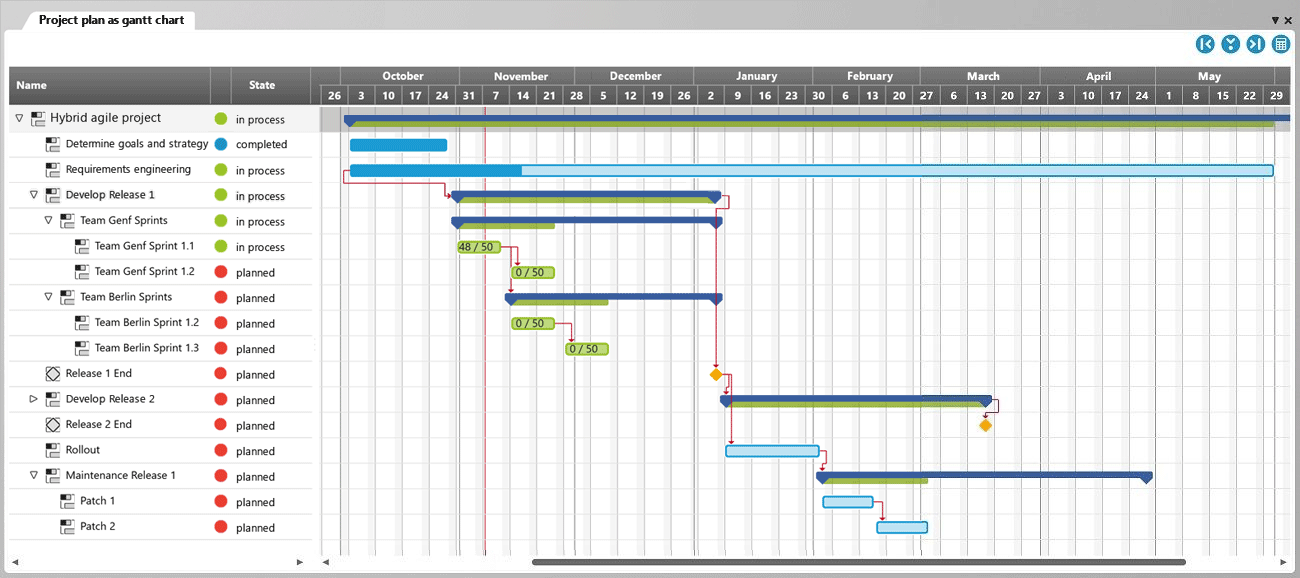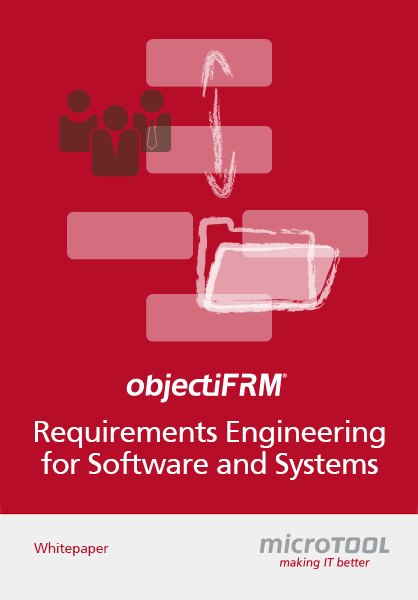Hybrid Project Management: The Best of Both Worlds
When should hybrid project management be used? What advantages does it offer?

Hybrid project management fuses classic and agile methods of project management. Businesses use it to work quickly, structured, flexibly and securely.
This Gantt chart shows classic activities like goal setting, requirements engineering or milestones. Agile elements like sprints with different teams are also produced here.
The contents of stories and tasks is not important for the production of a schedule, whereas the duration of sprints and releases is.
Challenges in Classic and Agile Projects
In classic projects, the project manager is responsible for the planning and control. They are the primary decision maker and therefore also responsible for the success of the project – that is, to make sure the fixed requirements, calculated costs and stipulated appointments are realized. The participation of internal and external customers is over when they sign the specification sheets. If the costs or duration of the project get out of hand, a lot of the time it is due to incomplete, changed or incorrectly understood requirements or a sneaky expansion of the scope. If the requirements are falsely estimated or if they change significantly, then it’s the project manager’s problem, and this problem can escalate to a problem with the customer.
Agile projects present the opposite of fixed appointments and costs. Requirements are not set in stone at the beginning, but rather developed step by step throughout the project together with the customer. In an ideal agile world, there is no role of a project manager – the responsibility for the success of the project is passed on to the Product Owner. They advance the project in the sense of the stakeholders. Their decisions don’t primarily concern costs and appointments, but rather the maximization of the possible value of the business or the stakeholders from the business areas.
This Is How Hybrid Project Management Works in Practice
Learn more about hybrid project management with objectiF RPM here »
To work agilely in an organization that is not agile outside of the
development presents a specific challenge for many businesses.
Working on Hybrid Projects
Do you want to develop an agile product, but need a schedule for your management? Do you work in a regulated branch where you have to follow rules and always act transparently? Do you want to work together in a team, without having to stick a piece of paper to the wall? Maybe you also want to change from conventional development to sprints with fixed durations and create a product increment with each sprint that creates additional value for your shareholders? Business situations can be very diverse, just like approaches in hybrid project management.
Hybrid Project Management Should …
… enable the flexible treatment of changes, a strong orientation towards market needs and shorten the duration of a project. Such expressions appear very quickly with the description of hybrid project management. They also always fit to agile approaches. Where flexibility is propagated, shorter development times are promised and results that are coordinated exactly for these target groups. If you want to use hybrid project management, you should register more than just the general advantages and also recognize your concrete requirements. And you should consider how you want to establish a bimodal approach.
Hybrid Organization or Hybrid Project Management?
There are often different approaches from within one organization. That is how the development area works agile with methods like Scrum, Kanban or Extreme Programming, whilst other areas like sales, controlling, marketing and communication work traditionally, with the classic approach. In such a hybrid organization, the approaches adapt to the organizational structure. Efficiency improvements can be realized in individual areas, whereas the bigger business potential remains unused.
Hybrid project management tries to link classic organizational structures and procedures with agile aspects. In such cases it is important to maintain an information exchange between the participants in the procedure. That is how stakeholders can take part in sprint reviews and scrum master and in the regular meetings of the project management organization. Information can be caused by marketing or sales activities and feedback from these areas can be used for the sprint planning. Decisions are easier to comprehend with open communication, and the understanding for other business areas and the acceptance of a common approach increases.
What Is Agile Project Management? How Does It Work? And What Are the Differences between Classic and Agile Project Management?
Hybrid project management – at its best with software
In large projects, the requirements of the stakeholders are often complex. The project team has to understand the requirements at the level of features and epics and refine them into user stories. As a basis for agile release planning, agile team planning and agile sprint planning, user stories have to be prioritized and valued. That means that teams need, on the one hand, techniques for agile requirements engineering like backlogs and backlog management. On the other hand, they need classic methods like schedules, milestones and documentation. This combination of agile and classic project planning and project control leads to a hybrid approach. Do you want to get to know a software for hybrid project management?

